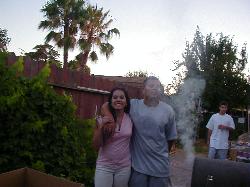Walter S Matthews
age ~80
from Folsom, CA
- Also known as:
-
- Walter Dr Matthews
- Walter Sid Matthews
- Walter S Mathews
- Sidney Mathews
- Phone and address:
-
646 Rogers Cir, Folsom, CA 95630
(916)6084521
Walter Matthews Phones & Addresses
- 646 Rogers Cir, Folsom, CA 95630 • (916)6084521
- El Dorado Hills, CA
- Williamsburg, IA
- Fremont, CA
- Sacramento, CA
Work
-
Company:New hampton grp
-
Address:4115 Southwestern Blvd, Mountain View, CA 94040
-
Phones:(650)9673543
-
Position:Director
-
Industries:Computer Programming Services
Isbn (Books And Publications)

Us Patents
-
Retro-Storing Analog Information In A Digital Storage Circuit
view source -
US Patent:56872798, Nov 11, 1997
-
Filed:Dec 23, 1994
-
Appl. No.:8/363379
-
Inventors:Walter S. Matthews - Folsom CA
-
Assignee:Intel Corporation - Santa Clara CA
-
International Classification:G11B 1722
-
US Classification:395 21
-
Abstract:A method for retro-storing analog information in a memory circuit first processes first analog data into first digitized data. The first digitized data are then stored in the memory circuit. Second analog data are then received and processed into second digitized data. If storage of the analog information is now required, the second digitized data are stored with the first digitized data in the memory circuit. If storage is not required, the first digitized data are deleted from the memory circuit and the second digitized data are stored in the memory circuit. An integrated storage circuit for retro-storing and retrieving analog information is also described. The circuit includes a control circuit for controlling a processing circuit to store digitized analog data in a nonvolatile memory in response to a control signal. When the control signal is not asserted, the control circuit controls the digitized analog data to be stored in the buffer circuit in a closed loop manner. When the control signal is asserted, the control circuit controls (1) the digitized analog data received after the control signal is enabled and (2) the digitized analog data already stored in the buffer circuit into the nonvolatile memory.
-
Ambidextrous Single Hand Chordic Data Management Device
view source -
US Patent:54325102, Jul 11, 1995
-
Filed:Mar 22, 1993
-
Appl. No.:8/034901
-
Inventors:Walter S. Matthews - Folsom CA
-
International Classification:B41J 508
G06F 302
H03K 1794 -
US Classification:341 20
-
Abstract:An ambidextrous, single hand data management device that has been ergonomically optimized to facilitate multiple key per character input, chording. The device has an arrangement of multiple keys which are so situated that the device can be held in either the left or the right hand, by a large range of hand sizes, and data can be quickly and conveniently input, that is, any combination of keys can be quickly and conveniently actuated with a "Microwriting" chordic type of data input, without a hand strap and without dropping the device. The ergonomic arrangement of keys on the casing allows for the device to remain stationary relative to the palm of the hand while that hand is in a multiplicity of orientations. The device can serve as a primary data input device or as a data storage and retrieval device for things like inventory control, names and addresses or daily schedule reminders or, as a combination of all of these. The device is primarily a mobile data input device that allows access to the entire keyboard of characters without the need to look while data are being input but which provides a visual feedback if desired as to what is being input with an LCD.
-
Method And Apparatus For Indexing An Analog Audio Recording And Editing A Digital Version Of The Indexed Audio Recording
view source -
US Patent:58939008, Apr 13, 1999
-
Filed:Mar 29, 1996
-
Appl. No.:8/623674
-
Inventors:Walter S. Matthews - Folsom CA
-
Assignee:Intel Corporation - Santa Clara CA
-
International Classification:G10L 300
G10L 302
G10L 900 -
US Classification:704200
-
Abstract:An apparatus for processing and editing an analog audio recording. An analog audio recording device comprises a data receiver for receiving analog audio data and a plurality of analog markers, an analog output for outputting the analog audio data with the plurality of analog markers, and a processing unit coupled to the analog output. The processing unit comprises digitizing circuitry for digitizing the analog audio data with the plurality of analog markers to create a digital audio file comprising digital audio data and a plurality of digital markers. The processing unit also comprises integrated circuit memory storing editing software for editing the digital audio file using the plurality of digital markers to create an edited digital audio file.
-
Electronic Carbon Paper
view source -
US Patent:56317417, May 20, 1997
-
Filed:Dec 29, 1995
-
Appl. No.:8/581279
-
Inventors:Walter S. Matthews - Folsom CA
-
Assignee:Intel Corporation - Santa Clara CA
-
International Classification:H04N 100
B41B 161 -
US Classification:358296
-
Abstract:An electronic copying apparatus provides a touch sensitive area placed under a paper on which an image is produced. Pressure on the touch sensitive area produced in rendering the image on the paper generates signals which are detected by a processor and stored as a series of pixel positions in a non-volatile solid-state memory array such as a flash EEPROM memory array. The image stored in the memory array may be read from the array by a computer and utilized as are other files in a computer.
-
System Having Two Pc Cards In A Hinged Carrying Case With Battery Compartment Within In The Hinge Section
view source -
US Patent:58482989, Dec 8, 1998
-
Filed:May 21, 1997
-
Appl. No.:8/861097
-
Inventors:Daniel C. Steere - Folsom CA
Homer T. Gee - Roseville CA
Walter S. Matthews - Folsom CA -
Assignee:Intel Corporation - Santa Clara CA
-
International Classification:G06F 1300
-
US Classification:395882
-
Abstract:A companion computer system for a host computer wherein the host computer includes an interface for electrically and mechanically interfacing to the companion computer. An example is a PCMCIA slot. The companion system includes a PC card with an interface which mates with the interface on the host. A bus is located on the PC card. A CPU is located on the PC card and connected to the bus. A display is located on the PC card and connected to the bus. An input device is located on the PC card and connected to the bus. A non-volatile memory module is located on the PC card and connected to the bus. A low power random access memory module is located on the PC card and connected to the bus. A power supply is located on the PC card and connected to the components of the PC card An operating system is located in the non-volatile memory.
-
Method And Data Storage System For Storing Data In Blocks Without File Reallocation Before Erasure
view source -
US Patent:58095586, Sep 15, 1998
-
Filed:Mar 17, 1997
-
Appl. No.:8/819688
-
Inventors:Walter S. Matthews - Folsom CA
Markus A. Levy - El Dorado Hills CA -
Assignee:Intel Corporation - Santa Clara CA
-
International Classification:G06F 1202
-
US Classification:711173
-
Abstract:A memory management method is provided for a nonvolatile memory having a plurality of blocks each of which can be electrically erased and programmed. A data file to be stored in the nonvolatile memory is received. A number of blocks that are available for data storage are located from the plurality of blocks. The data file is stored in a first block of the number of blocks if the size of the data file is smaller than the total storage space of the first block. The data file is stored in the first block and a second block of the number of blocks if the size of the data file is larger than the total storage space of the first block but smaller than the total storage space of the first and second blocks. Unoccupied space of the first or second block by the data file is not used to store other data files such that no file reallocation operation is needed when the first or second block is to be erased. A data storage system having an erasable and programmable memory and a memory management program is also described.
-
Modular Pcmcia Card
view source -
US Patent:56193963, Apr 8, 1997
-
Filed:Feb 21, 1995
-
Appl. No.:8/391110
-
Inventors:Homer T. Gee - Roseville CA
Daniel C. Steere - Folsom CA
Walter S. Matthews - Folsom CA -
Assignee:Intel Corporation - Santa Clara CA
-
International Classification:H05K 720
G06F 120 -
US Classification:361686
-
Abstract:A modular PCMCIA card comprises a base member conforming to the Type I or Type II physical dimensions and an add on section which mechanically and electrically connects with the base member and has dimensions such that when the base member and the add on section are joined, they conform to the dimensions of a PCMCIA Type III card. The add on section may contain one or more functional units of a stand alone computer system and may also contain a battery, a modem, pager and/or an infrared transceiver for communicating with printers, computers or controlling other devices.
-
Method For Performing A Continuous Over-Write Of A File In Nonvolatile Memory
view source -
US Patent:58601244, Jan 12, 1999
-
Filed:Sep 30, 1996
-
Appl. No.:8/722979
-
Inventors:Walter S. Matthews - Folsom CA
Clark S. Thurlo - Folsom CA
MacDonald Verner - El Dorado Hills CA
Deborah L. See - Placerville CA
Phillip J. del Pozo - Folsom CA -
Assignee:Intel Corporation - Santa Clara CA
-
International Classification:G06F 1212
-
US Classification:711165
-
Abstract:A nonvolatile memory having a plurality of individually erasable blocks is used to store sectors of a file. A method of overwriting the file includes the step of receiving a frame of data. The logical sector that the frame is to be written to is determined. The logical sector corresponds to a first sector located at a first offset in a first block of the nonvolatile memory. The first block also has an associated first logical block number. The frame of data is written to a second sector. The second sector is located at a second offset in a spare block. The first and second offsets are identical. The logical block number of the spare block is updated to be the same as the first logical block number.
Name / Title
Company / Classification
Phones & Addresses
Director
New Hampton Grp
Computer Programming Services
Computer Programming Services
4115 Southwestern Blvd, Mountain View, CA 94040
WALTER E. MATTHEWS & ASSOCIATES, INC
RIVER M THOROUGHBRED COMPANY
Resumes

Independent Photography Professional
view sourceLocation:
Sacramento, California Area
Industry:
Photography

Walter Matthews
view sourceLocation:
United States

Walter Matthews
view sourceLocation:
United States
Youtube

Walter Arnold Matthews
view source
Walter Matthews
view source
Walter Matthews
view source
Walter Matthews
view source
Walter Matthews
view source
Walter Matthews
view source
Walter L. Matthews
view source
Walter Mark Matthews
view sourceClassmates

Walter Gonzalez (Matthews)
view sourceSchools:
Adams Elementary School Stockton CA 1994-1995
Community:
Robert Bowen, Terry Poling

Walter Matthews
view sourceSchools:
Olive Elementary School Orange CA 1970-1971, Vicentia Elementary School Corona CA 1976-1978, Letha Raney Junior High School Corona CA 1978-1981
Community:
Jim Perry

Walter Matthews
view sourceSchools:
Greenfield High School Greenfield MA 1961-1965
Community:
Susan Campobello, Dennis Peter

Walter Matthews
view sourceSchools:
Austin High School Knoxville TN 1960-1964
Community:
John Calloway, Gerald Burdine, W Taylor, Arlie Wilson, Jo Irwin

Walter Matthews
view sourceSchools:
Kennedy School Delta Saudi Arabia 1969-1973
Community:
Robert Kosterman, Richard Hiebert, Laurie Hart, Arlene Vaillancourt

Walter Matthews
view sourceSchools:
Girardville High School Girardville PA 1956-1960
Community:
Verla Currence, Charles Grady, Albert Tenaglia

Walter Matthews
view sourceSchools:
Lansdowne High School Lansdowne PA 1938-1942
Community:
Brother Baker

Walter Matthews
view sourceSchools:
South Mountain High School Phoenix AZ 1993-1997
Community:
Julian French
Flickr
Googleplus

Walter Matthews
Work:
Southern Quarters Inc. - C.E.O. (1998)
Education:
Argosy University - Criminal Justice

Walter Matthews
Education:
Tuskegee University

Walter Matthews

Walter Matthews

Walter Matthews

Walter Matthews

Walter Matthews

Walter Matthews
Get Report for Walter S Matthews from Folsom, CA, age ~80













